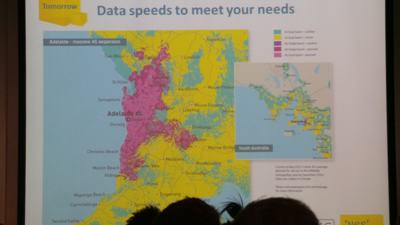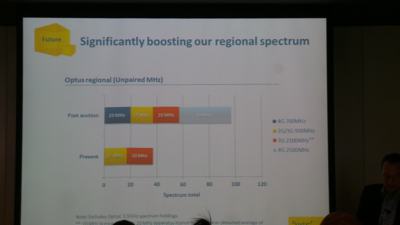
Optus plans to go multi-band and hit 70% of Australian Metro by the mid 2014. But what happens to existing devices?
Optus had previously flagged its plans to launch TD-LTE services in Canberra by mid-year, and today is the day that it’s officially switching on that network for Canberra users, albeit in a trial mode with two available TD-LTE 4G devices. Optus’ outgoing MD Günther Ottendorfer told Fat Duck Tech it’s trialling with around forty customers at the moment, with devices set to go on sale from the 4th of June.
Optus says it’s rolled out the TD-LTE sites in Canberra — 12 at the moment — in consultation with Japanese telco firm Softbank to gauge TD-LTE rollout strategies. Ottendorfer showed off Japanese TD-LTE smartphones, including what appeared to be a TD-LTE variant of the Motorola RAZR M — but announced no Australian TD-LTE smartphones as yet.

The new TD-LTE network has a theoretical limit of 70Mbps, and Optus is bullish about how close to that customers will actually get. According to Ottendorfer “We have seen speeds there of 61Mbps in practical use”.
Optus also spoke at length about its plans for its network for the rest of the year and beyond. Aside from Canberra, Ottendorfer stated that Optus has around 1,000 new sites to roll out, although the exact mix of FD-LTE and TD-LTE isn’t clear.

What is clear is that if you’ve got an existing FD-LTE device (Optus branded or otherwise) you won’t have a straight software update path (which is understandable) and you won’t get access to the TD-LTE network. Optus was reluctant to say whether there would be any kind of sweetener for existing Optus customers to upgrade to the new modems, stating simply that they’d make those commercial decisions in the coming weeks.
As for the new devices, they’re visually ostensibly similar to the existing Huawei devices, but work as multi-mode devices across both the TD-LTE and FD-LTE networks, which is a big part of Optus’ ongoing strategy. Optus was one of the successful bidders in the digital dividend auction, and in the 700MHz spectrum it’s set to acquire in 2015 will form a large part of its regional strategy, where it admits its previous coverage hasn’t been ideal, although it claims it’s done a lot of work refarming its 3G capacity across Australia.

Optus claims that following its 3G refarming project, dubbed 3GPlus, it now has 98% population coverage for its 3G network. It’s worth bearing in mind that 98% of the Australian population doesn’t cover 98% of the land mass. We’re a remarkably coast-hugging bunch, and those figures are for outdoor coverage in any case. In 2007, Optus claimed it had 60% of the population covered; by 2009 it had increased that to 96% coverage.